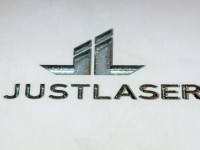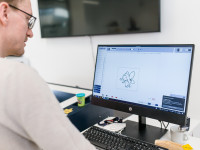Laser cutting plastic
Instructions, tips and what you should avoid
Laser cutting plastic is an advanced process that has become increasingly popular in recent years. It enables precise cuts and markings to be made on various types of plastic and is frequently used in the advertising, architecture, automotive and electronics industries.
Introduction to plastic lasering: How does it work and why is it a popular method?
Plastic lasering is a popular method for processing and shaping plastics. But how does it actually work?
In this process, a laser beam is directed at the material, causing the plastic to melt or vaporize at the corresponding point. Thanks to the precise control of the laser, even complex shapes and patterns can be applied to the material.
One advantage of plastic lasering is that it is very fast and therefore also suitable for larger quantities. In addition, various types of plastic can be lasered, including particularly resistant materials such as ABS or polycarbonate.
So it's no wonder that plastic lasering is used in many sectors - from the advertising industry to the automotive industry and medical technology, there are numerous areas of application for plastic lasered products.
Instructions for laser cutting plastic:
- Choose the right plastic: Not all plastics are suitable for lasering. Acrylic, polycarbonate, polyamide and polyethylene terephthalate (PETG) are best suited. These materials have a low melting temperature and can be cut precisely. Some plastics, such as PVC, release harmful vapors during laser cutting. It is essential to find out about the suitability of the material in order to avoid health risks and damage to the device.
- Prepare your laser: Make sure your laser is clean and well maintained. Check that the lens is clean and free of dirt. Clean the work area and remove all unnecessary items.
- Import your design: Import your design into the laser software. Check that the dimensions and settings are correct. If you have a 3D design, you will need to convert it to 2D.
- Choose the correct settings: The settings depend on the type of plastic and the thickness. Check the manufacturer's recommendations and adjust the settings accordingly.
- Test your settings: Before you start the actual cutting, you should always carry out a test. Cut a small piece of the plastic and check that the settings are correct.
The right choice of laser for your plastics application: What factors need to be considered?
When it comes to plastic lasers, it is crucial to choose the right laser for your application. There are various types of lasers that differ in their wavelength, power and focusing.
Choosing the wrong laser can lead to undesirable results, such as blurred edges or melt marks on the surface of the plastic. Therefore, you should consider several factors when choosing the right laser, such as the thickness and type of plastic, the desired pattern or design and the required accuracy and speed of processing.
Another important factor is the price of the laser and its service life. With careful planning and expert advice, you can ensure that you select the best laser for your specific requirements and thus achieve optimum results.
Safety precautions for plastic lasering: Important measures to avoid accidents
When laser cutting plastic, it is particularly important to take the necessary safety precautions to avoid accidents and injuries. This includes wearing protective clothing such as gloves or safety goggles.
Adequate ventilation of the work area is also essential to protect against harmful vapors and gases. In addition, only trained employees should work with the laser system and strictly adhere to all precautionary measures. Regular maintenance of the device and professional disposal of waste are other important measures to ensure safety when laser cutting plastics. By taking these precautions, potential risks can be minimized so that you can concentrate on your work and achieve creative results.
Sources of error in plastic lasering and how to rectify them
There are several sources of error in plastic laser cutting that can lead to undesirable results. One common cause of errors is incorrect adjustment of the laser cutting power or cutting speed. If this is set too high or too low, this can lead to blurred cuts or melting or discoloration of the workpiece. An incorrect choice of beam quality or geometry can also cause problems. Another problem is contamination on the workpiece or in the surrounding area, which can impair the laser beam.
But don't worry: many of these sources of error can be avoided or eliminated with thorough preparation and regular maintenance of the laser system. By familiarizing yourself with the basics of plastic lasering and continuously improving your skills, you will soon be able to successfully implement even more complex projects and fully express your creativity!
Frequent areas of application for plastic-lasered products
Plastic lasering is one of the most popular methods for processing plastics. There is a wide range of applications for plastic lasered products. Signage and logos are a common area of application, as they can be applied particularly precisely and permanently using lasers. Personalized promotional gifts such as pens or key rings can also be individually designed with the laser.
However, plastic laser-cut parts are also used in the automotive industry and in the manufacture of medical devices. The diverse possibilities of plastic lasering open up countless creative design options and make it an attractive technology for many industries and areas of application. With the right knowledge and skills, anyone can take advantage of plastic lasering and produce innovative products that will delight customers.
Signage and logos
Signage and logos are one of the most common applications for plastic lasered products. Plastic lasering offers the ability to create precise, clean lines and letters on a variety of surfaces. The use of laser technology also ensures permanent marking that will not fade or peel. This makes it ideal for indoor and outdoor signage as well as logos on various products such as pens, keyrings and badges. Lasering allows you to strengthen your brand and make it uniform. There are many ways to use lasers to bring your design to life - from simple engravings to more complex cuts in shapes such as circles or stars. With plastic lasers, there are virtually no limits to your creativity!
Promotional gifts and personalized items
Personalized promotional gifts and items are a great way to promote your brand and build customer relationships. Plastic lasering offers many possibilities and benefits. For example, you can apply logos or lettering to various plastic products to make them unique and personalized. The laser also allows you to engrave fine details or complex designs into the material with precision. This gives you high-quality results that are durable and ideal for use as promotional items. With personalized plastic products, you can ensure that your brand stays in the minds of your customers - whether at trade fairs or other occasions.
Laser cutting plastic requires expertise and care to achieve the best results. By following the above instructions and tips and avoiding common mistakes, you can ensure that every project is a success. The innovation and precision of laser cutting opens up unlimited possibilities in the processing of plastics, from industrial applications to creative projects.


